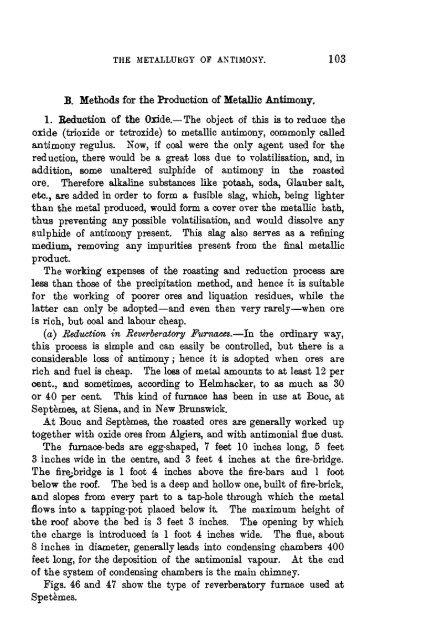A N T I M O N Y : ITS HISTORY, CHEMISTRY, MINERALOGY ...
A N T I M O N Y : ITS HISTORY, CHEMISTRY, MINERALOGY ...
A N T I M O N Y : ITS HISTORY, CHEMISTRY, MINERALOGY ...
You also want an ePaper? Increase the reach of your titles
YUMPU automatically turns print PDFs into web optimized ePapers that Google loves.
THE METALLURGY OF ANTIMONY. 103<br />
B. Methods for the Production of Metallic Antimony.<br />
1. Eeduction of the Oxide.—The object of this is to reduce the<br />
oxide (trioxide or tetroxide) to metallic antimony, commonly called<br />
antimony regulus. Now, if coal were the only agent used for the<br />
reduction, there would be a great loss due to volatilisation, and, in<br />
addition, some unaltered sulphide of antimony in the roasted<br />
ore. Therefore alkaline substances like potash, soda, Glauber salt,<br />
etc., are added in order to form a fusible slag, which, being lighter<br />
than the metal produced, would form a cover over the metallic bath,<br />
thus preventing any possible volatilisation, and would dissolve any<br />
sulphide of antimony present. This slag also serves as a refining<br />
medium, removing any impurities present from the final metallic<br />
product.<br />
The working expenses of the roasting and reduction process are<br />
less than those of the precipitation method, and hence it is suitable<br />
for the working of poorer ores and liquation residues, while the<br />
latter can only be adopted—and even then very rarely—when ore<br />
is rich, but coal and labour cheap.<br />
(a) Reduction in Reverberatory Furnaces.—In the ordinary way,<br />
this process is simple and can easily be controlled, but there is a<br />
considerable loss of antimony; hence it is adopted when ores are<br />
rich and fuel is cheap. The loss of metal amounts to at least 12 per<br />
cent., and sometimes, according to Helmhacker, to as much as 30<br />
or 40 per cent. This kind of furnace has been in use at Bouc, at<br />
Septemes, at Siena, and in New Brunswick.<br />
At Bouc and Septemes, the roasted ores are generally worked up<br />
together with oxide ores from Algiers, and with antimonial flue dust.<br />
The furnace-beds are egg-shaped, 7 feet 10 inches long, 5 feet<br />
3 inches wide in the centre, and 3 feet 4 inches at the fire-bridge.<br />
The fire-bridge is 1 foot 4 inches above the fire-bars and 1 foot<br />
below the roof. The bed is a deep and hollow one, built of fire-brick,<br />
and slopes from every part to a tap-hole through which the metal<br />
flows into a tapping-pot placed below it. The maximum height of<br />
the roof above the bed is 3 feet 3 inches. The opening by which<br />
the charge is introduced is 1 foot 4 inches wide. The flue, about<br />
8 inches in diameter, generally leads into condensing chambers 400<br />
feet long, for the deposition of the antimonial vapour. At the end<br />
of the system of condensing chambers is the main chimney.<br />
Figs. 46 and 47 show the type of reverberatory furnace used at<br />
Spetemes.

















